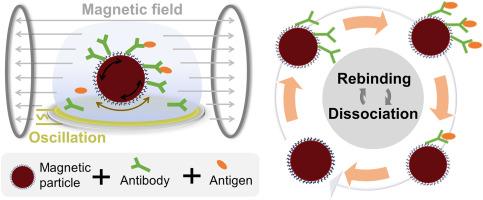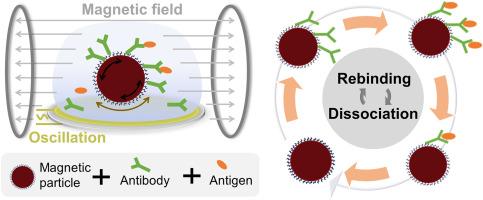Residence time prediction in magnetically controlled biomolecular local rebinding-dissociation kinetics
IF 5.7
2区 化学
Q1 CHEMISTRY, ANALYTICAL
引用次数: 0
Abstract
The residence time of drug-target conjugates is a critical factor in drug screening and efficacy prediction. The local rebinding-dissociation kinetics gives insights into in-vivo drug-target interactions. A magnetic torque system (MTS) is designed to observe rebinding-dissociation kinetics for predicting residence time. The system utilizes an alternating magnetic field (AMF) to manipulate the magnetization motion of magnetically labeled biomolecules and the forces acting upon biomolecular bonds. The motion, sensed by a quartz crystal microbalance (QCM), reflects biomolecular interactions occurring at the particle surface. Meanwhile, the motion facilitates the separation of dissociated molecules from the surface, thereby obviating the necessity for fixed and mobile phases in common kinetics observations. The constant and static solution environment minimizes reagent consumption. The MTS was utilized to observe the local rebinding-dissociation of antibodies (PAB and MAB) to magnetic beads (MB) and to HER2 receptors. The residence times recorded by the MTS were larger than the results obtained via SPR method, due to the occurrences of rebinding-dissociation kinetics. Interaction behaviours can be meticulously regulated for varying affinities by modulating the intensity of magnetic field. A high intensity field (400 Oe) was applied for strong binding between antibody-MB (biotin-streptavidin), and a low intensity field (300 Oe) was applied for weak antigen-antibody interactions. An increase in AMF strength enhanced dissociation, with a shift from 300 Oe to 400 Oe resulting in a 1 ∼ 4-fold reduction in residence time. Overall, the MTS provides an interactive and customizable perspective on kinetics observations.


磁控生物分子局部再结合-解离动力学中的停留时间预测
药物-靶标共轭物的停留时间是药物筛选和药效预测的关键因素。局部再结合-解离动力学有助于深入了解体内药物与靶点的相互作用。设计了一种磁力矩系统(MTS)来观察重新结合-解离动力学,以预测停留时间。该系统利用交变磁场(AMF)来操纵磁标记生物分子的磁化运动以及作用在生物分子键上的力。由石英晶体微天平(QCM)感应的运动反映了颗粒表面发生的生物分子相互作用。同时,这种运动有助于从表面分离解离的分子,从而避免了普通动力学观测中固定相和流动相的必要性。恒定和静态的溶液环境最大限度地减少了试剂消耗。MTS 用于观察抗体(PAB 和 MAB)与磁珠(MB)和 HER2 受体的局部再结合-解离过程。由于存在重新结合-解离动力学,MTS 记录的停留时间大于 SPR 方法获得的结果。通过调节磁场强度,可以细致地调节不同亲和力的相互作用行为。高强度磁场(400 Oe)适用于抗体-MB(生物素-链霉亲和素)之间的强结合,低强度磁场(300 Oe)适用于抗原-抗体之间的弱相互作用。AMF 强度的增加增强了解离效果,从 300 Oe 到 400 Oe 的转变导致停留时间缩短了 1 ∼ 4 倍。总之,MTS 为动力学观察提供了一个互动和可定制的视角。
本文章由计算机程序翻译,如有差异,请以英文原文为准。
求助全文
约1分钟内获得全文
求助全文
来源期刊

Analytica Chimica Acta
化学-分析化学
CiteScore
10.40
自引率
6.50%
发文量
1081
审稿时长
38 days
期刊介绍:
Analytica Chimica Acta has an open access mirror journal Analytica Chimica Acta: X, sharing the same aims and scope, editorial team, submission system and rigorous peer review.
Analytica Chimica Acta provides a forum for the rapid publication of original research, and critical, comprehensive reviews dealing with all aspects of fundamental and applied modern analytical chemistry. The journal welcomes the submission of research papers which report studies concerning the development of new and significant analytical methodologies. In determining the suitability of submitted articles for publication, particular scrutiny will be placed on the degree of novelty and impact of the research and the extent to which it adds to the existing body of knowledge in analytical chemistry.
 求助内容:
求助内容: 应助结果提醒方式:
应助结果提醒方式:


